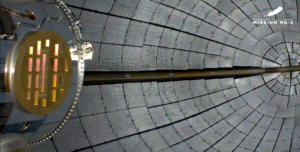Blue Origin’s New Glenn Reaches Orbit
Blue Origin successfully launched the New Glenn rocket for the first time this morning, but fell short on landing the reusable first stage on a barge in the Atlantic. The company, owned by Jeff Bezos, already launches the New Shepard rocket carrying passengers and other payloads on short suborbital flights, but this was its first attempt at orbital flight. Named after John Glenn, the first U.S. astronaut to reach orbit, New Glenn will deliver payloads to Earth orbit and beyond, including Human Landing Systems to the Moon for NASA.
The two-stage rocket, dubbed “So You’re Telling Me There’s a Chance,” lifted off from Launch Complex 36 at Cape Canaveral Space Force Station, FL at 2:03 am ET.
We did it! Orbital. Great night for Team Blue. On to spring and trying again on the landing. (Here is another view!) pic.twitter.com/3AZGfkXQvB
— Dave Limp (@davill) January 16, 2025
An earlier attempt on Monday was scrubbed due to ice forming in a purge line on an auxiliary power unit. Today’s launch came despite a challenging weather forecast and an unplanned delay after a “wayward” boat entered restricted waters.
Entering unplanned hold due to range red for a wayward boat. New T-0 forthcoming.
— Blue Origin (@blueorigin) January 16, 2025
The primary goal for this first flight, New Glenn-1 (NG-1), was achieving orbit as the first of two certification missions required before DOD will use the rocket for its most valuable payloads. It did that, but Blue Origin also hoped to land the first stage on a barge in the Atlantic similar to how SpaceX recovers Falcon 9 first stages. Blue Origin’s barge, or “landing ship,” is named Jacklyn after Bezos’s mother.
That part of the mission did not go as planned. Three of the seven BE-4 engines did relight about 7 minutes and 30 seconds after launch, but the webcast did not show what happened after that apparently due to loss of data. Company President David Limp acknowledged it had been “an ambitious goal” for the first flight and they will try again in the spring.
The second stage continued on its way to orbit and completed the planned two burns. This first flight was carrying only one payload, the company’s own Blue Ring Pathfinder, inside the 7-meter fairing and it was not intended to separate. Blue Origin said it was successfully receiving data.

This one is just a test. When operational, Blue Ring will be able to accommodate as many as 13 payloads with a mass of up to 3 MT and deploy each of them into various Earth orbits or cislunar space. The company advertises that Blue Ring will provide “end-to-end services that span hosting, transportation, refueling, data relay, and logistics, including an ‘in-space’ edge computing capability.” Blue Ring Pathfinder was developed as part of DOD’s Defense Innovation Unit’s (DIU’s) Orbital Logistics Vehicle project.
New Glenn can put 45 Metric Tons (MT) into low Earth orbit or 13 MT into geostationary transfer orbit and is also capable of sending payloads to the Moon. Blue Origin is one of two companies under contract to NASA to provide Human Landing Systems for the Artemis program to ferry astronauts from lunar orbit down to and back from the lunar surface. SpaceX is the other and will provide the first two for Artemis III, the first time U.S. astronauts will set foot on the Moon since the Apollo program, and Artemis IV. Blue Origin’s Blue Moon lander will be used for Artemis V.
This article has been updated.
User Comments
SpacePolicyOnline.com has the right (but not the obligation) to monitor the comments and to remove any materials it deems inappropriate. We do not post comments that include links to other websites since we have no control over that content nor can we verify the security of such links.